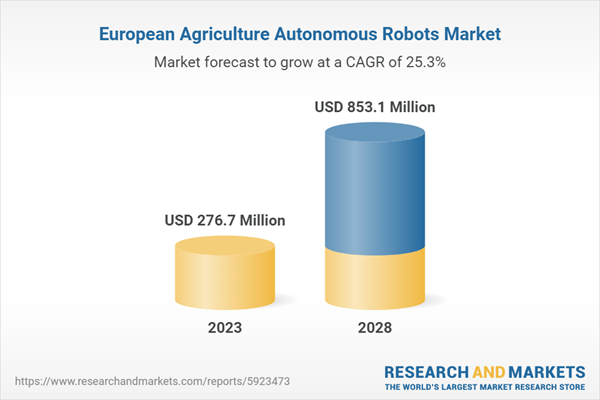10% Free customization
Introduction to Europe Agriculture Autonomous Robots Market This report comes with 10% free customization, enabling you to add data that meets your specific business needs.
The Europe agriculture autonomous robots market (excluding U.K.) was valued at $276.7 million in 2023, and it is expected to grow with a CAGR of 25.25% during the forecast period to reach $853.1 million by 2028. The increasing demand for efficient and sustainable agricultural techniques is predicted to fuel growth in the worldwide agriculture autonomous robots market.
Agriculture autonomous robots are advanced technologies built for farming without the constant intervention of humans. They are equipped with sensors and artificial intelligence and can plant, weed, harvest, and monitor crops. These robots navigate fields, make choices in real time, and increase agricultural yield by minimizing manual work. Crop harvesting robots, weeding robots, milking robots, and monitoring robots are just a few examples. These technologies, which are transforming farming operations, optimize production, reduce worker dependency, conserve resources, and increase product quality.
Market Introduction
The Europe agriculture autonomous robot market pertains to the utilization of autonomous robots in various agricultural activities. These robots are programmed to carry out tasks like planting, harvesting, watering, and monitoring crops, among others, without human intervention. The increasing adoption of advanced technologies in the agriculture sector, such as robotics, AI, and IoT, has driven the growth of this market in Europe.The use of autonomous robots in agriculture offers several advantages. Firstly, these robots can perform tasks efficiently and accurately, resulting in higher productivity and better crop yields. Secondly, they can operate round the clock, helping farmers save time and increasing operational efficiency. Additionally, autonomous robots can minimize the need for manual labor, addressing the challenges associated with labor shortages in the agriculture industry.
Moreover, these robots can contribute to sustainable agriculture by optimizing resource utilization, reducing chemical usage, and mitigating soil erosion. They can also provide precise data and analysis, enabling farmers to make informed decisions about crop management and harvesting.
With the increasing demand for food, the Europe agriculture autonomous robot market is poised for significant growth. Factors such as government initiatives to promote precision farming and the rising trend of smart farming are expected to drive the adoption of autonomous robots in the European agriculture sector.
Market Segmentation:
Segmentation 1: by Application
- Crop Monitoring
- Livestock Monitoring and Management
- Harvesting and Picking
- Weeding
- Others
Segmentation 2: by Product
- Crop Harvesting and Picking Robot
- Weeding Robot
- Milking Robot
- Crop and Livestock Monitoring Robot
- Others
Segmentation 3: by Country
- Germany
- France
- Italy
- Greece
- Ukraine
- Netherlands
- Belgium
- Switzerland
- Rest-of-Europe
How can this report add value to an organization?
Product/Innovation Strategy: The product segment helps the reader understand the different technologies used for agriculture autonomous robots and their potential in Europe region. Moreover, the study gives the reader a detailed understanding of the different solutions provided by the agriculture autonomous robot equipment providers, such as imaging, AI, and analyzing. Compared to conventional agricultural methods, the agriculture autonomous robots market enables more exact targeting of planting, weeding, and harvesting, allowing farmers to save money by maximizing the use of their inputs.Growth/Marketing Strategy: The Europe agriculture autonomous robots market has seen major development by key players operating in the market, such as business expansion, partnership, collaboration, and joint venture. The favored strategy for the companies has been partnership, collaboration, and joint venture activities to strengthen their position in the Europe agriculture autonomous robots market.
Competitive Strategy: Key players in the Europe agriculture autonomous robots market analyzed and profiled in the study, including their market segments covered by distinct products, applications served, and regional presence, as well as the influence of important market tactics. Moreover, a detailed competitive benchmarking of the players operating in the agriculture autonomous robots market has been done to help the reader understand how players stack against each other, presenting a clear market landscape. Additionally, comprehensive competitive strategies such as partnerships, agreements, and collaborations will aid the reader in understanding the untapped revenue pockets in the market.
Key Market Players and Competition Synopsis
The companies that are profiled have been selected based on inputs gathered from primary experts and analyzing company coverage, product portfolio, and market penetration.Some Prominent Names Established in the Market are:
- Saga Robotics AS
- DAIRYMASTER
- GEA Group Aktiengesellschaft
- Lely
- Robert Bosch GmbH
- Trabotyx
This product will be delivered within 3-5 business days.
Table of Contents
1 Markets
2 Regions
3 Markets - Competitive Benchmarking & Company Profiles
4 Research Methodology
List of Figures
List of Tables
Companies Mentioned
- Saga Robotics AS
- DAIRYMASTER
- GEA Group Aktiengesellschaft
- Lely
- Robert Bosch GmbH
- Trabotyx
Table Information
| Report Attribute | Details |
|---|---|
| No. of Pages | 73 |
| Published | January 2024 |
| Forecast Period | 2023 - 2028 |
| Estimated Market Value ( USD | $ 276.7 Million |
| Forecasted Market Value ( USD | $ 853.1 Million |
| Compound Annual Growth Rate | 25.2% |
| Regions Covered | Europe |
| No. of Companies Mentioned | 6 |









